Related Research Articles

Carl Philipp Emanuel Bach, also formerly spelled Karl Philipp Emmanuel Bach, and commonly abbreviated C. P. E. Bach, was a German Classical period composer and musician, the fifth child and second surviving son of Johann Sebastian Bach and Maria Barbara Bach.

Johann Joachim Quantz was a German composer, flutist and flute maker of the late Baroque period. Much of his professional career was spent in the court of Frederick the Great. Quantz composed hundreds of flute sonatas and concertos, and wrote On Playing the Flute, an influential treatise on flute performance. His works were known and appreciated by Bach, Haydn and Mozart.
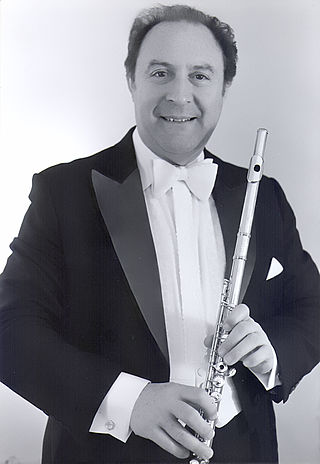
Jean-Pierre Louis Rampal was a French flautist. He has been personally "credited with returning to the flute the popularity as a solo classical instrument it had not held since the 18th century."
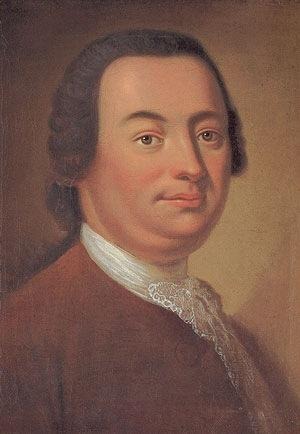
Johann Christoph Friedrich Bach was a German composer and harpsichordist, the fifth son of Johann Sebastian Bach, sometimes referred to as the "Bückeburg Bach".

Trevor David Pinnock is a British harpsichordist and conductor.
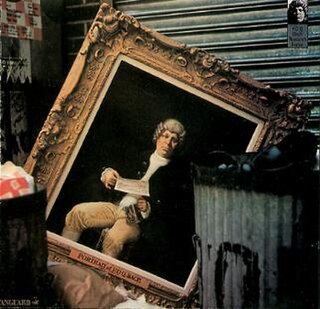
P. D. Q. Bach is a fictional composer invented by the American musical satirist Peter Schickele, who developed a five-decade-long career performing the "discovered" works of the "only forgotten son" of the Bach family. Schickele's music combines parodies of musicological scholarship, the conventions of Baroque and Classical music, and slapstick comedy. The name "P. D. Q." is a parody of the three-part names given to some members of the Bach family that are commonly reduced to initials, such as C. P. E., for Carl Philipp Emanuel Bach; PDQ is an initialism for "pretty damned quick".
The Sonata in C major for flute and basso continuo is a sonata in 4 movements. It is attributed to Johann Sebastian Bach in the manuscript, which is in the hand of his son Carl Philipp Emanuel Bach and has been dated to about 1731, although scholars question the attribution

The Sonata in E major for flute and basso continuo is a sonata for transverse flute and figured bass composed by J. S. Bach in the 1740s. It was written as the result of a visit in 1741 to the court of Frederick the Great in Potsdam, where Bach's son Carl Philipp Emanuel had been appointed principal harpsichordist to the king the previous year. It was dedicated to Michael Gabriel Fredersdorf, the king's valet and private secretary, who, like the king, was an amateur flautist.
The Trio Sonata for Two Flutes in A minor, F. 49, BR B15, is one of three trio sonatas for paired flutes and basso continuo composed c. 1740 by Wilhelm Friedemann Bach while organist at the Dresden Sophienkirche. The manuscript is in the Central State Archives Museum of Literature and Arts of Ukraine in Kyiv.
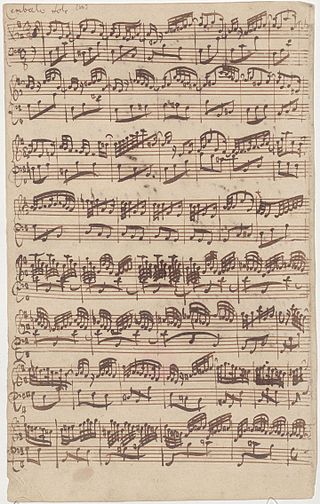
The Partita for keyboard No. 6 in E minor, BWV 830, is a suite of seven movements written for the harpsichord by Johann Sebastian Bach. It was published in 1731 both as a separate work and as part of Bach's Clavier-Übung I.
The Orchestral Suite in G minor, BWV 1070 is a work by an unknown composer. It is part of the Bach-Werke-Verzeichnis catalogue of the works of J. S. Bach, and sometimes called the "Orchestral Suite No. 5", but was almost certainly not composed by him. It is more likely that the composer was his son W. F. Bach. It is a French suite with an overture and several dances, which has a similar structure to the 4 orchestral suites known to have been written by J. S. Bach. Evidence for its not being by the older composer includes the form of the opening movement, which differs from that used in the suites known to be by him, and the fact that the third movement is in a different key to the rest of the work, whereas J. S. Bach's suites are homotonal.

BWV Anh., abbreviation of Bach-Werke-Verzeichnis Anhang, is a list of lost, doubtful, and spurious compositions by, or once attributed to, Johann Sebastian Bach.

The sonatas for viola da gamba and harpsichord, BWV 1027–1029, are three sonatas composed by Johann Sebastian Bach for viola da gamba and harpsichord. They probably date from the late 1730s and early 1740s.
The Concerto, BWV 525a, is a trio sonata in C major for violin, cello and basso continuo, based on material otherwise found in Johann Sebastian Bach's first Organ Sonata, BWV 525, and Flute Sonata in A major, BWV 1032. The oldest extant manuscript containing the BWV 525a arrangement, D-B Mus.ms. Bach St 345, is dated to the middle of the 18th century. Although this version of Bach's sonata movements may have originated during his lifetime in the circle around him, it seems unlikely that the composer supervised, or even ordered, the manufacture of the string trio adaptation, thus the arrangement has been listed in BWV Anh. II, that is the Anhang (Anh.) of doubtful works, in the 1998 edition of the Bach-Werke-Verzeichnis (BWV). Breitkopf & Härtel published BWV 525a in 1965. Digital facsimiles of 18th- and 19th-century manuscript copies of the arrangement, in which the sonata is titled "Concerto", became available in the 21st century.

The organ sonatas, BWV 525–530 by Johann Sebastian Bach are a collection of six sonatas in trio sonata form. Each of the sonatas has three movements, with three independent parts in the two manuals and obbligato pedal. The collection was put together in Leipzig in the late 1720s and contained reworkings of prior compositions by Bach from earlier cantatas, organ works and chamber music as well as some newly composed movements. The sixth sonata, BWV 530, is the only one for which all three movements were specially composed for the collection. When played on an organ, the second manual part is often played an octave lower on the keyboard with appropriate registration. Commentators have suggested that the collection might partly have been intended for private study to perfect organ technique, some pointing out that its compass allows it to be played on a pedal clavichord. The collection of sonatas is generally regarded as one of Bach's masterpieces for organ. The sonatas are also considered to be amongst his most difficult compositions for the instrument.
The Triple Concerto, BWV 1044, is a concerto in A minor for traverso, violin, harpsichord, and string orchestra by Johann Sebastian Bach. He based the composition on his Prelude and Fugue BWV 894 for harpsichord and on the middle movement of his Organ Sonata BWV 527, or on earlier lost models for these compositions.
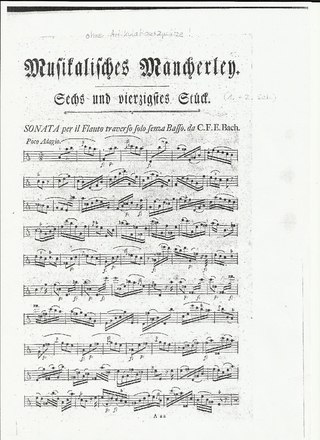
The Sonata for Solo Flute in A minor, Wq.132, H 562, is a sonata for flute, without Basso Continuo or accompanying instruments, composed by Carl Philipp Emanuel Bach. The sonata is considered, along with Telemann's Fantasias for Solo Flute and J. S. Bach's A minor partita, one of the most significant works for unaccompanied flute before the 20th century. It is the sole flute work by Bach that was printed and published during his lifetime. No manuscript of it has been discovered.
References
- ↑ Schulenberg, David. "Chronology of C.P.E. Bach's Works" . Retrieved 2008-02-09.
- ↑ Schulenberg, David. "Helm Catalog of C.P.E. Bach's Works" . Retrieved 2008-02-09.
- ↑ "Description page for Berkeley Sonata". Chester Music. Retrieved 2008-02-09.
- James Galway/Martha Argerich, RCA Red Seal LRL1-5095 Stereo (1975)